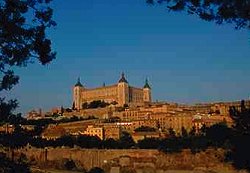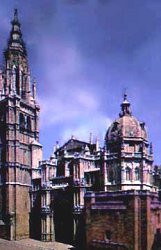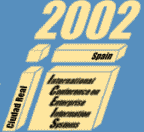|
Saturday April, 6th,
after lunch. You can register
on the reception desk. TOLEDO
(Fee: 20
€).
Inhabitants:
59.600
Altitude: 529 m above sea level
Distances:
Madrid: 71 km
Ciudad Real: 115 km
Guadalajara: 129 km
Avila: 137 km
Cuenca: 187 km
Salamanca: 234 km |

Toledo and its Alcázar
|
Like a Travel through History
Toledo is one of the most important centers of european medieval
history. The first one to report about it was Roman author Titus Livius,
who describes it as a "small fortificated town", and
fortification has always been an important parameter in its history, still
evident to today's tourist for the monumental walls around, and the
"Swords of Toledo" gave to its steel-production world-wide fame.
It was capital of Spain from the Gothic epoch until 1560, fact that
explains its really impressive medieval architecture. Walking through its
streets one feels like having stepped back into the Middle-Ages, but in
the best sense of it, and perhaps you will search your pockets for a few
gold-ducats to buy some of Toledo's fine artisany or just to enjoy of its
highly recommandable cuisine.
Sightseeing
Toledo, having been declared National
Monument by the Spanish state, seems to be one large museum. Hardly
another town is so well conserved in its historical style.
The best way to explore Toledo certainly is to have a long walk through it
and look at the buildings of various epochs:
- The Epoch of Romans
-
Titus Livius described
the Roman "Toletum" as a small fortificated
settlement. But already then it had great strategical importance. The Amphitheater
and an aqueductus are conserved of that time.
- The Epoch of Goths
-
When the Goths conquered Spain
in 6th century, they made Toledo capital of their empire. A
remind of this epoch is the Fortress of San Servando.
- The Epoch of Moors
-
Tolaitola, as the Moors
called Toledo, was one of the most important northern-spanish towns.
There are two Mosques and three town-gates left.
The Mosque Mezquita del Cristo de la Luz, of 10th
century, is extraordinarily well-conserved. Its construction, with
nine cupolas raising over four Gothic colums, certainly shows
influences of the great Mosque of Cordoba.
The town-gate Vieja Puerta de la Bisagra, built during 12th
and 13th century, is the most impressive rest of the
Moorish fortifications
Spaniards had religious freedom during the Moorish occupation, so also
Christians (Mozarabes) built their churches: San Sebastián
and Santa Eulalia were made during that time, though both were
modified lateron.
- The Epoch of the Reconquest
-
After conquering Toledo in 1085,
Alfons VI made the town capital of his empire. As a consequence
the importance of the town was growing rapidly and arrivede to its
climax in late 15th and early 16th century. The Escuela
de Traductores de Toledo (School of Translators of Toledo)
cultivated as well classical as oriental knowledge and exported it
from here to the occidental world.
During the Moorish dominance the Christians had developed an
architectonic style of their own, though clearly influenced by Arabian
aesthetics. In this so-called Mudejar-style they built now
several churches that are well worth a visit: Santiago del Arrabal,
Cristo de la Vega, San Vicente, San Miguel, San
Román and Santo Tomé. (In the latter is exposed one of El
Greco's most famous paintings, "The Funeral of Count
Orgaz".)
The two synagogues conserved in Toledo, Sinagoga de Santa
María La Blanca and Sinagoga de El Tránsito, are in Mudejar
style as well. The latter, built by Samuel Ha Leví, became a
temple of Christian Alcantara Order after the banishing of Jews
in late 15th century. The Cathedral built between 1226 and 1492, with massive lines and
decorations in Mudejar style is certainly the most interesting
gothic building in town. You may visit its fantastic collection of
paintings, including works of El Greco, Goya and Van Dyck
in its vestry, and the treasury with the famous 16th
century monstrance of Juan de Arfe, which is part and parcel of
the Corpus Christi procession.
The mighty Bridge of San Martin over Tajo river, with a
tower at each end, is of gothic style as well.
The church Iglesia de San Juan de los Reyes and its Monastery
were built in 15th century for the Spanish kings to be
buried there. The claustrum is of extraordinary beauty.

-
Cathedral of Toledo
-
-
-
-
- After 15th Century
-
In 1560, under the government of
King Philip II, Madrid replaced Toledo as capital of Spain. The
town anyhow remained important, specially for the Catholic Church
which held there no fewer than 18 counciles.
The old Hospital of Santa Cruz, founded in late 16th
century by Cardenal Mendoza, serves today as Museum of Arts
and Archaeology. Outstanding from the architectonical point of
view are the staircase of Covarrubias, the Plateresque
facade and the courtyard.
Important Renaissance buildings are the churches Santo Domingo el
Antiguo and San José, and the town-gate Puerta Nueva de
la Bisagra.
Of Baroque epoch are the church San Juan de los Jesuitas and,
of course, the works of Toledo's most famous painter, El Greco:
many of them are exposed in the house where he was living, Casa y
Museo del Greco.
Finally, behind the Arco de la Sangre, an arch well known to
all who read Cervantes' Don Quijote, we find the town's
landmark, the Alcazar.
Page Updated on 06-03-2002
Copyright © Escola Superior de Tecnologia
de Setúbal, Instituto Politécnico de Setúbal |



